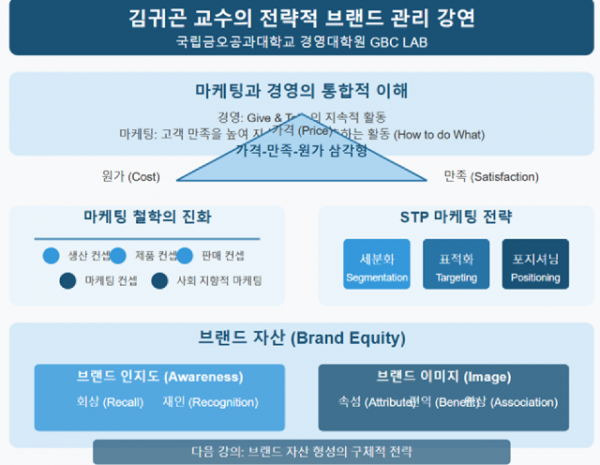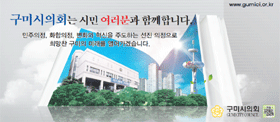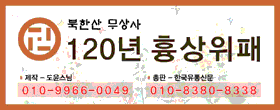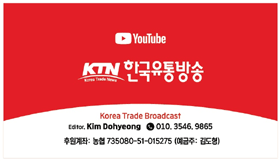[GBC기획] 전략적 브랜드 관리(1)
김귀곤 교수의 전략적 브랜드 관리 강연 정리
2025.3.5.
김귀곤 교수의 전략적 브랜드 관리 강연
강연자: 김귀곤 교수 (국립금오공과대학교 경영대학교 GBC LAB 지도교수)
대상: 대학원생
3월 5일 김귀곤 교수는 전략적 브랜드 관리 강연을 통해, 학문적 깊이와 현장 적용 가능성을 겸비한 통찰력 있는 분석을 제시했다. 본 강연은 브랜드 마케팅의 본질과 전략적 접근법에 대한 깊이 있는 이해를 제공하며, 특히 학계와 실무를 잇는 실질적인 프레임워크를 제시했다는 점에서 주목할 만하다.
1. 마케팅과 경영의 통합적 이해:
김 교수는 브랜드 마케팅을 논하기에 앞서 경영과 마케팅의 기본 개념을 명확히 정의했다. 경영은 ‘기브 앤 테이크(Give & Take)'가 지속적으로 일어나는 활동으로 정의하고, 이러한 활동의 궁극적인 목표는 고객과의 지속적인 관계 구축에 있다고 강조했다. 여기서 경영자의 역할은 가격(Price)을 고객의 만족(Satisfaction)과 기업의 원가(Cost) 사이에 위치시키는 것이라고 덧붙였다. 구체적으로, 기업은 생산 및 운영 활동을 통해 원가를 낮추고, 마케팅 활동을 통해 고객 만족도를 높이는 데 집중해야 한다.
이러한 관점에서 마케팅은 ‘고객 만족을 높여 기브 앤 테이크가 지속적으로 일어나게 하는 활동'으로 규정되며, 핵심은 ‘How to do what'이다. 즉, '어떻게(How to do)' 고객에게 (What)을 제공하여 만족도를 높일 것인가에 대한 고민이 마케팅의 본질이라는 것이다.
2. 마케팅 철학의 진화:
김 교수는 마케팅 컨셉의 발전 과정을 ‘경영 철학'이라는 흥미로운 관점에서 조망했다. 초기 경영자들은 생산 컨셉, 제품 컨셉, 판매 컨셉 등의 단편적인 접근에 머물렀지만, 점차 소비자 관점의 마케팅 컨셉을 통해 진정한 고객 만족을 추구하게 되었다고 설명했다. 특히 현대에는 기업의 사회적 책임을 강조하는 사회 지향적 마케팅 컨셉(ESG 경영, CSR 등)이 부상하고 있으며, 이는 기업이 개인의 만족, 사회적 가치, 기업 이윤을 동시에 추구하는 '트라이앵글' 모델을 지향해야 함을 시사한다.
3. STP 마케팅 전략의 핵심:
본 강연에서는 효과적인 고객 욕구 충족 방안으로 STP(Segmentation, Targeting, Positioning) 마케팅 전략이 상세하게 소개되었다. 이 전략의 핵심은 고객의 다양한 욕구를 동질적인 그룹으로 묶어 세분화(Segmentation)하고, 특정 세분 시장을 표적 시장으로 선정(Targeting)한 후, 4P Mix(Product, Price, Place, Promotion)를 활용하여 고객의 마음속에 경쟁 우위를 구축하는 포지셔닝(Positioning)을 시행하는 것이다.
김 교수는 포지셔닝을 "표적 고객의 마음속에 경쟁 우위를 자리 잡게 만드는 것"이라고 정의하며, 단기적인 노력으로는 달성하기 어려우며, 지속적인 마케팅 활동과 브랜드 관리를 통해 장기적으로 구축해야 한다고 강조했다.
4. 브랜드 자산의 중요성과 소비자 중심 접근:
김 교수는 브랜드 마케팅의 궁극적인 목표가 ‘브랜드 자산(brand equity) 구축’에 있다고 강조했다. 여기서, 핵심은 브랜드 자산은 기업 내부의 관점이 아닌, 소비자 관점에서 평가되어야 한다는 점이다. 즉, 소비자가 해당 브랜드를 인지하고, 긍정적인 이미지를 보유하고 있을 때, 브랜드 자산 가치가 높다고 할 수 있다. 한편 김귀곤 교수는 자산은 asset이지만 “브랜드 자산으로 읽고 brand equity로 써야 한다”고 강조했다.
특히, 소비자의 브랜드 지식은 브랜드 인지도(Awareness)와 브랜드 이미지(Image)로 구성되며, 브랜드 인지도는 회상(Recall)과 재인(Recognition)이라는 두 가지 측면으로 구분된다는 점을 강조했다. 또한, 브랜드 이미지는 속성(Attribute, 제품 관련/미관련 속성), 편익(Benefit, 기능적/상징적/경험적/사회적 편익), 연상(Association) 등 다양한 요소의 결합으로 형성되므로, 획일적인 정의를 내리기 어렵다는 점을 지적했다.
5. 브랜드 아이덴티티와 브랜드 컨셉의 역할:
김 교수는 브랜드 자산 구축을 위해 기업이 주도적으로 설정해야 하는 요소로 브랜드 아이덴티티(Identity)와 브랜드 컨셉(Concept)을 제시했다. 브랜드 아이덴티티는 기업이 소비자에게 인지되기를 바라는 브랜드의 모습이며, 브랜드 컨셉은 핵심적인 메시지를 담아 브랜드 아이덴티티를 구체화한 것이다. 기업은 4P Mix를 통해 브랜드 컨셉을 소비자에게 효과적으로 전달하고, 소비자의 마음속에 브랜드 이미지를 구축함으로써 브랜드 자산을 증진시켜야 한다.
총평:
김귀곤 교수의 이번 강연은 이론적 토대와 실질적인 적용 방안을 결합하여 브랜드 마케팅의 핵심 원리를 명쾌하게 제시했다는 점에서 높이 평가할 만하다. 특히, 기존의 브랜드 마케팅 연구가 간과했던 ‘소비자 관점’의 중요성을 강조하고, 이를 브랜드 자산 구축 전략에 통합적으로 반영했다는 점에서 의미가 있다. 김 교수는 이번 강연을 통해 단순한 이론 교육을 넘어, 수강생들이 브랜드 마케팅 전문가로 성장할 수 있도록 돕고자 하는 그의 열정과 헌신을 확인할 수 있었다. 다만 시간이 제한되어 더욱 풍부한 사례 연구를 소개하지 못한 점은 아쉬움으로 남는다.
다음 강의:
브랜드 자산 형성에 대한 이해를 바탕으로 브랜드를 어떻게 자산으로 만들 수 있을지 구체적으로 설명한다.
(본 리포트는 강연 내용에 기반하여 작성되었으며, 개인적인 의견은 배제되었음을 밝힙니다.)
Professor Kim Gwi-gon's Strategic Brand Management Lecture Organized
2025.3.5.
Professor Kim Gui-gon's Strategic Brand Management Lecture
Lecturer: Professor Kim Gwi-gon (Professor of GBC LAB, College of Business, Kumoh National Institute of Technology)
Target: Graduate student
Professor Kim Gui-gon presented an insightful analysis that combines academic depth and field applicability through a strategic brand management lecture on March 5. This lecture is particularly noteworthy in that it provides an in-depth understanding of the nature of brand marketing and a practical framework linking academia and practice.
1. Integrated understanding of marketing and management:
Before discussing brand marketing, Professor Kim clearly defined the basic concepts of management and marketing. He emphasized that management defines 'Give & Take' as an activity that takes place continuously, and that the ultimate goal of these activities is to establish a continuous relationship with customers. He added that the manager's role here is to position the price between the customer's satisfaction and the company's cost. Specifically, companies should focus on lowering costs through production and operation activities and increasing customer satisfaction through marketing activities.
From this point of view, marketing is defined as 'an activity that increases customer satisfaction and causes give and take to occur continuously', and the core is 'How to do what'. In other words, the essence of marketing is to think about how to provide (what) to customers to increase satisfaction.
2. Evolution of marketing philosophy:
Professor Kim viewed the development process of the marketing concept from the interesting perspective of 'management philosophy'. Early managers explained that they remained in fragmentary approaches such as production concepts, product concepts, and sales concepts, but gradually came to pursue true customer satisfaction through marketing concepts from a consumer perspective. In particular, in the modern era, social-oriented marketing concepts (ESG management, CSR, etc.) that emphasize corporate social responsibility are emerging, suggesting that companies should pursue a 'triangle' model that simultaneously pursues individual satisfaction, social values, and corporate profits.
3. Key to STP marketing strategy:
In this lecture, the STP (Segmentation, Targeting, Positioning) marketing strategy was introduced in detail as an effective way to satisfy customer needs. The core of this strategy is to segment the customer's various needs into homogeneous groups, select a specific segmented market as a target market (targeting), and use 4P Mix (Product, Price, Place, Promotion) to implement positioning to build a competitive advantage in the customer's mind.
Professor Kim defined positioning as "making a competitive advantage in the minds of target customers" and emphasized that it is difficult to achieve with short-term efforts and that it should be built in the long term through continuous marketing activities and brand management.
4. The Importance of Branded Assets and a Consumer-Focused Approach:
Professor Kim emphasized that the ultimate goal of brand marketing is to build brand equity. The key here is that brand equity should be evaluated from the consumer's point of view, not the internal point of view of the company. In other words, it can be said that the value of brand equity is high when consumers recognize the brand and have a positive image. Meanwhile, Professor Kim Gwi-gon emphasized that it is an asset asset, but "you should read it as a brand asset and write it as a brand equity."
In particular, it was emphasized that consumers' brand knowledge consists of brand awareness and brand image, and brand awareness is divided into two aspects: Recall and Recognition. In addition, it was pointed out that it is difficult to make a uniform definition because the brand image is formed by a combination of various factors such as attributes, product-related/unrelated attributes, benefits, functional/symbolic/experiential/social benefits, and association.
5. Roles of brand identity and brand concept:
Professor Kim suggested brand identity and brand concept as factors that companies must take the lead in setting up brand assets. Brand identity is the image of a brand that a company wants to be recognized by consumers, and the brand concept is a concrete version of the brand identity with a core message. Companies should effectively deliver brand concepts to consumers through 4P Mix and promote brand assets by building a brand image in consumers' minds.
General review:
Professor Kim Gwi-gon's lecture is highly appreciated in that it clearly presented the core principles of brand marketing by combining the theoretical foundation and practical application plan. In particular, it is meaningful in that it emphasizes the importance of 'consumer perspective' that existing brand marketing research has overlooked and reflects it integrally in brand asset building strategies. Through this lecture, Professor Kim was able to confirm his enthusiasm and dedication to helping students grow into brand marketing experts beyond simple theoretical education. However, it remains regrettable that he was unable to introduce richer case studies due to limited time.
Next lecture:
Based on an understanding of brand asset formation, it explains in detail how a brand can be made an asset.
(This report is based on the contents of the lecture and reveals that personal opinions have been excluded.)
<저작권자(c)한국유통신문. 무단전재-재배포 금지>
기사제보 및 사회적 공헌활동 홍보기사 문의: 010-3546-9865, flower_im@naver.co
검증된 모든 물건 판매 대행, 중소상공인들의 사업을 더욱 윤택하게 해주는
#StrategicBrandManagement #BrandMarketing #ProfessorKimGwiGon #MarketingLecture #BrandEquity #MarketingStrategy #STPMarketing #BusinessEducation #KumohNationalInstitute #GraduateLecture #MarketingConcepts #ConsumerBehavior #ESGMarketing #CSR #BrandIdentity #BrandAssets
#전략적브랜드관리 #브랜드마케팅 #김귀곤교수 #마케팅강의 #브랜드자산 #마케팅전략 #STP마케팅 #경영교육 #금오공과대학교 #대학원강의 #마케팅개념 #소비자행동 #ESG경영 #CSR #브랜드아이덴티티 #브랜드자산



























